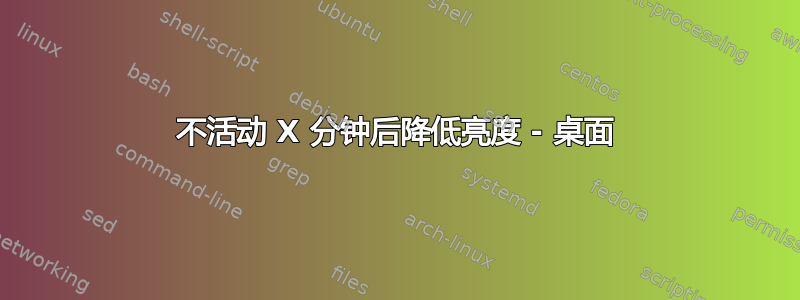
我使用桌面工作站为客户运行应用程序,我想在 X 分钟后将亮度降低 Y%(不关闭屏幕)。我无法在桌面上实现这一点。我可以让暗淡功能正常工作。有什么解决办法吗?
答案1
在 x 秒后使屏幕变暗的脚本
如果计算机处于空闲状态(没有鼠标或键盘的输入),下面的脚本将在任意秒数后使屏幕变暗
剧本
#!/usr/bin/env python3
import subprocess
import time
import sys
# read arguments from the run command: idel time (in seconds
dimtime = int(sys.argv[1])*1000
# brightness when dimmed (between 0 and 1)
dimmed = sys.argv[2]
def get(cmd):
# just a helper function
return subprocess.check_output(cmd).decode("utf-8").strip()
# get the connected screens
screens = [l.split()[0] for l in get("xrandr").splitlines()
if " connected" in l]
# initial state (idle time > set time
check1 = False
while True:
time.sleep(2)
# get the current idle time (millisecond)
t = int(get("xprintidle"))
# see if idle time exceeds set time (True/False)
check2 = t > dimtime
# compare with last state
if check2 != check1:
# if state chenges, define new brightness...
newset = dimmed if check2 else "1"
# ...and set it
for scr in screens:
subprocess.Popen([
"xrandr", "--output", scr, "--brightness", newset
])
# set current state as initial one for the next loop cycle
check1 = check2
如何使用
该脚本需要
xprintidle:sudo apt install xprintidle- 将脚本复制到一个空文件中,另存为
dimscreens.py 测试——从终端运行它,使用空闲时间和所需亮度(暗淡状态)作为参数:
python3 /path/to/dimscreens.py 20 0.6脚本会在 20 秒后将屏幕亮度调暗至 60%。
如果一切正常,添加到启动应用程序:Dash>启动应用程序>添加命令:
/bin/bash -c "sleep 10 && python3 /path/to/dimscreens.py 20 0.6"
解释
一个简单的方法来设置屏幕亮度为您的目的(例如 50%):
xrandr --output <screenname> --brightness 0.5
该脚本使用打印空闲定期获取当前空闲时间,并将其与上一个周期进行比较:
while True:
time.sleep(2)
t = int(get("xprintidle"))/1000
check2 = t > dimtime
如果时间超过设定时间或者跳回unidle,脚本采取行动:
if check2 != check1:
newset = dimmed if check2 else "1"
for scr in screens:
subprocess.Popen([
"xrandr", "--output", scr, "--brightness", newset
])
...将亮度设置为 1 (=100%) 或设置暗亮度。
有关代码的更详细解释在脚本中。
笔记
事实上,脚本会使所有屏幕变暗。如果您只需要设置一个屏幕,那么所有屏幕都是可能的。
答案2
Wayland 方式
感谢@jacob-vlijm,这里有一个针对 Wayland 用户修改的脚本。
我将它用于带触摸屏的 odroid m1 设备,因此我只需要控制一个屏幕。
解释
用法:./dimscreen.py backlight 5 20
- 背光-屏幕名称,从中获取
brightnessctl -l - 5 秒后空闲
- 20 - 亮度值介于 0 和 255 之间,另请参阅
brightnessctl -l
保存并恢复旧的亮度值,而不仅仅是全亮度。
您需要安装包brightnessctl。
由于 brightctl 需要 root 权限,因此设置 suid 位以以普通用户身份运行它:
sudo chmod u+s /usr/bin/brightnessctl
xprintidle已被取代dbus-send,感谢https://askubuntu.com/a/1231995/801283
脚本
#!/usr/bin/env python3
import subprocess
import time
import sys
# screen to dim
screen = sys.argv[1]
# read arguments from the run command: idel time (in seconds)
dimtime = int(sys.argv[2])*1000
# brightness when dimmed (between 0 and 255)
dimmed = sys.argv[3]
def get_cmd(cmd):
return subprocess.Popen(["/bin/bash", "-c", cmd], stdout=subprocess.PIPE, stderr=subprocess.STDOUT, universal_newlines=True)
def set_cmd(cmd):
subprocess.Popen(["/bin/bash", "-c", cmd], stdout=subprocess.PIPE, stderr=subprocess.STDOUT, universal_newlines=True)
get_idleTime = "dbus-send --print-reply --dest=org.gnome.Mutter.IdleMonitor /org/gnome/Mutter/IdleMonitor/Core org.gnome.Mutter.IdleMonitor.GetIdletime"
get_brightness = "brightnessctl -d " + screen + " g"
set_brightness = "brightnessctl -d " + screen + " s "
# initial state (idle time > set time)
check1 = False
oldBrightness = "255"
while True:
time.sleep(1)
# get the current idle time (millisecond)
idleTime = int((get_cmd(get_idleTime)).communicate()[0].rsplit(None,1)[-1])
# see if idle time exceeds set time (True/False)
check2 = idleTime > dimtime
# compare with last state
if check2 != check1:
# if state chenges, define new brightness...
newBrightness = dimmed if check2 else oldBrightness
oldBrightness = get_cmd(get_brightness).communicate()[0].rsplit(None,1)[0]
# ...and set it
set_cmd(set_brightness + newBrightness)
# set current state as initial one for the next loop cycle
check1 = check2


